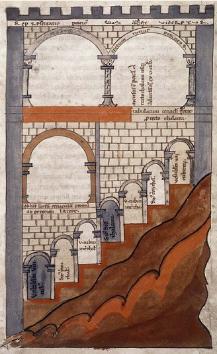Paradises Lost and Found: representing the invisible in the Middle Ages
Overview
This module will introduce students to the images and spaces of medieval spiritual experiences from the early to the high Middle Ages (c. 500 – 1300). Students will examine representations of Paradise, Hell, and the desperate attempts of medieval artists and writers to create a tangible witness to the ineffable and invisible. The module will explore the earliest attempts to realise a spiritual paradise in the desert by the church fathers, to the numerous depictions of the celestial Jerusalem in later manuscripts.
Paradise was meant to encourage humanity to participate within the framework of Christian ethics; similarly, its antithesis, Hell, was meant to detract people from sin. Images of both were used to teach and to warn the medieval Christian about the life that potentially awaited them, leaving an extraordinary visual record that we will investigate. Representations of these and many other spaces appear in a variety of contexts, including architecture, sculpture, wall-painting, and in manuscripts, each telling us something about the audiences for these images.
The promises of Paradise did not stop others from trying to construct pale reflections of it on earth. Monastic foundations, the rising spires of Gothic architecture, and the meticulous representations of the buildings of Scripture all attempt to visualise and convey aspects of a spiritual experience. The subject of medieval space is popular across a range of disciplines, and by taking this module students will be able to participate in that discussion in a meaningful way, making strides in the development of this area of research. The module will encourage and support an interdisciplinary approach to the material, incorporating texts and images to address the question: how was the invisible represented in the Middle Ages?
Aims
By the end of the module, students should have acquired:
- a strong knowledge of the medieval spiritual and mystical sources in visual and textual sources
- an in-depth knowledge of the application of theories of space to a medieval context
- confidence in the identification and analysis of relationships between texts and images
- confidence in the written and spoken presentation of research findings and conclusions
Preliminary Reading
- Christiania Whitehead, Castles of the Mind: a Study of Medieval Architectural Allegory (Cardiff, 2003)
- Mary Carruthers, The Craft of Thought: Meditation, Rhetoric, and the Making of Images, 400-1200 (Cambridge, 1998)
- Madeline H. Caviness, ‘Images of the divine Order and the Third Mode of Seeing’, Gesta 22 (1983), pp. 99-120
- Mircea Eliade, The Sacred and the Profane: the Nature of Religion (San Diego, 1987)
- Roberta Gilchrist, Gender and Material Culture: the Archaeology of Religious Women (London, 1994)

Module information
- Module title
Paradises Lost and Found: representing the invisible in the Middle Ages- Module number
HOA00078M- Convenor
For postgraduates
